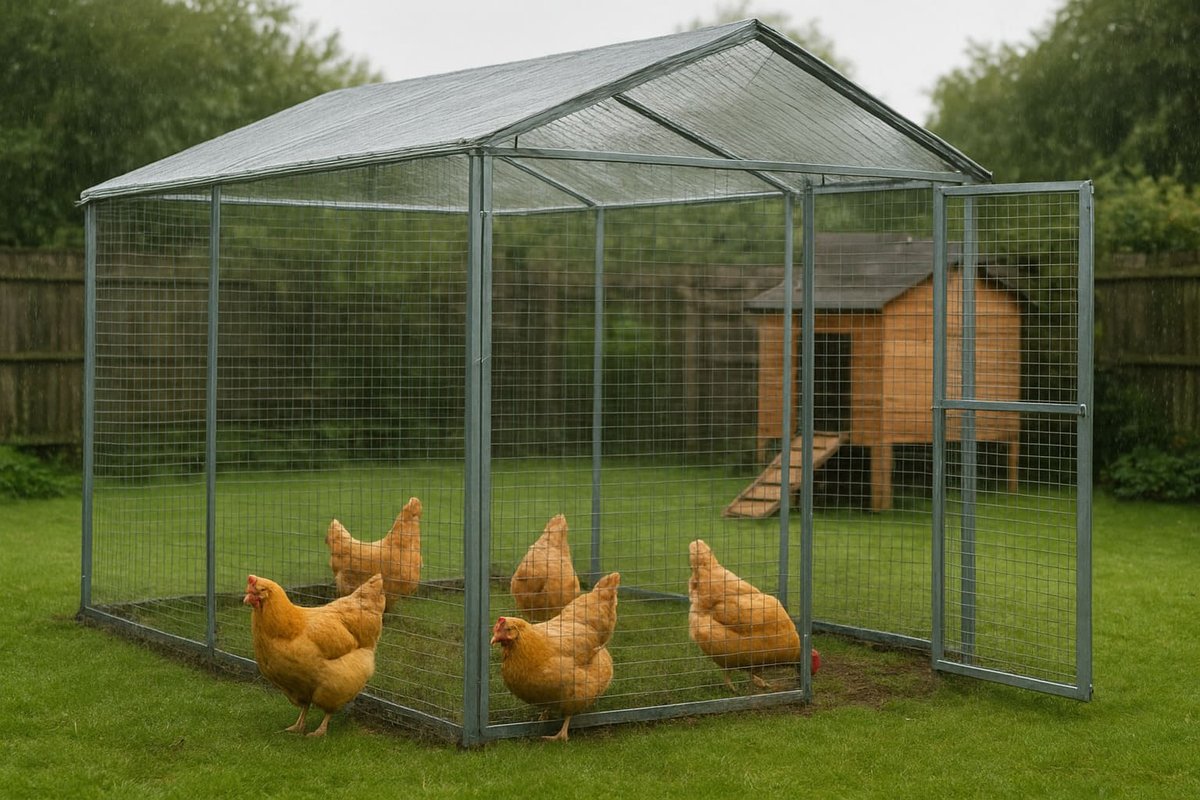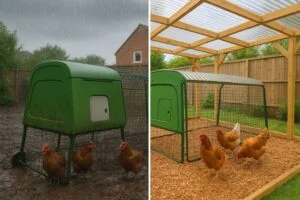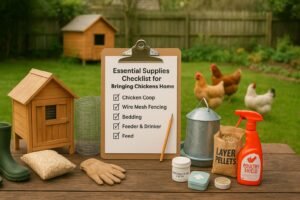As a UK hen keeper, I know that foxes are sneaky and the rain is relentless! I remember my first flock huddled under a sad-looking bush, and I knew I needed a better solution. If you’re tired of crouching in a small coop and want to give your hens a safe, spacious place to roam, you’ve come to the right place. This walk-in chicken run review is your complete guide to choosing the perfect enclosure for your back garden flock.
We’ll cover everything from sturdy wooden chicken runs to easy-to-assemble pre made chicken run kits. We’ll look at the importance of proper chicken run roofing to beat the British weather and compare it to a metal chicken run with roof. My goal is to help you find the best chicken runs UK has to offer, whether you need a heavy-duty fortress or the best affordable chicken coop and run combo.
We’ll explore plenty of walk-in chicken run ideas to make your hens happy and safe. This walk in chicken run review comparing the best kits in the UK 2025 will look at top brands, where to find walk-in chicken runs for sale, and most importantly, how to make your setup a walk in chicken run fox proof haven for your feathered friends.
A walk-in run, or poultry pen, isn’t just a luxury; it’s a game-changer for both you and your chickens. It gives them a safe foraging space, protected from predators, and makes cleaning and feeding so much easier for you. We’ll also touch on semantic essentials like a predator-resistant backyard hen run to ensure your setup meets UK biosecurity standards (per DEFRA 2025). Let’s dive in and find the perfect fit for your garden.
What Size Walk In Chicken Run Do I Need?
Choosing the right size is the first, and most important, step. Too small, and your hens will get stressed and bored. Too big, and you might be taking up precious garden space. The key is to follow UK welfare guidelines while also being practical about your own garden and flock.
According to welfare organisations like the RSPCA, each hen should have a minimum of 1 square metre (about 10 sq ft) of space in their run. However, for happy, healthy hens that will spend a lot of time in their enclosure, it’s much better to aim for 2 square metres (around 21 sq ft) per bird. This advice is backed up by detailed RSPCA welfare guidelines, which cover the risks of overcrowding.
Why Space is So Important
A cramped run is a recipe for disaster. Overcrowding leads to:
- Bullying: Chickens establish a ‘pecking order’, and in tight spaces, lower-ranking birds can get bullied and injured.
- Boredom: A lack of space leads to destructive behaviours like feather-pecking.
- Health Issues: Disease spreads much faster in crowded conditions. A build-up of droppings can also lead to respiratory problems and parasites.
Here are answers to some common questions:
- How many sq ft does a chicken need in a run? Aim for at least 10-15 sq ft per hen as a minimum, but always provide more if you can.
- How many chickens can fit in a 4×6 run? A 4×6 run is 24 sq ft. That’s only enough for 2-3 hens at most. It’s a bit tight, so you’d want to let them free-range often.
- How many chickens can fit in a 10×10 run? A 10×10 run is 100 sq ft, which is a great size for 8-10 hens, giving them plenty of space.
- How many chickens can fit in a 4×8 run? A 4×8 run provides 32 sq ft of space, making it comfortable for 3-4 hens.
To make it easier, here’s a quick-glance table:
| Run Size | Sq Ft (approx.) | Max Chickens (UK Guidelines) | Notes |
|---|---|---|---|
| 4×6 ft | 24 | 2-3 hens | Best for small flocks; consider an outside chicken run extension. |
| 4×8 ft | 32 | 3-4 hens | A good starter size; make sure it has chicken run roofing for rain. |
| 10×10 ft | 100 | 8-10 hens | Ideal for families; a fox proof walk in chicken run design is essential. |
For more on calculating space, check out our detailed guide to chicken space requirements.
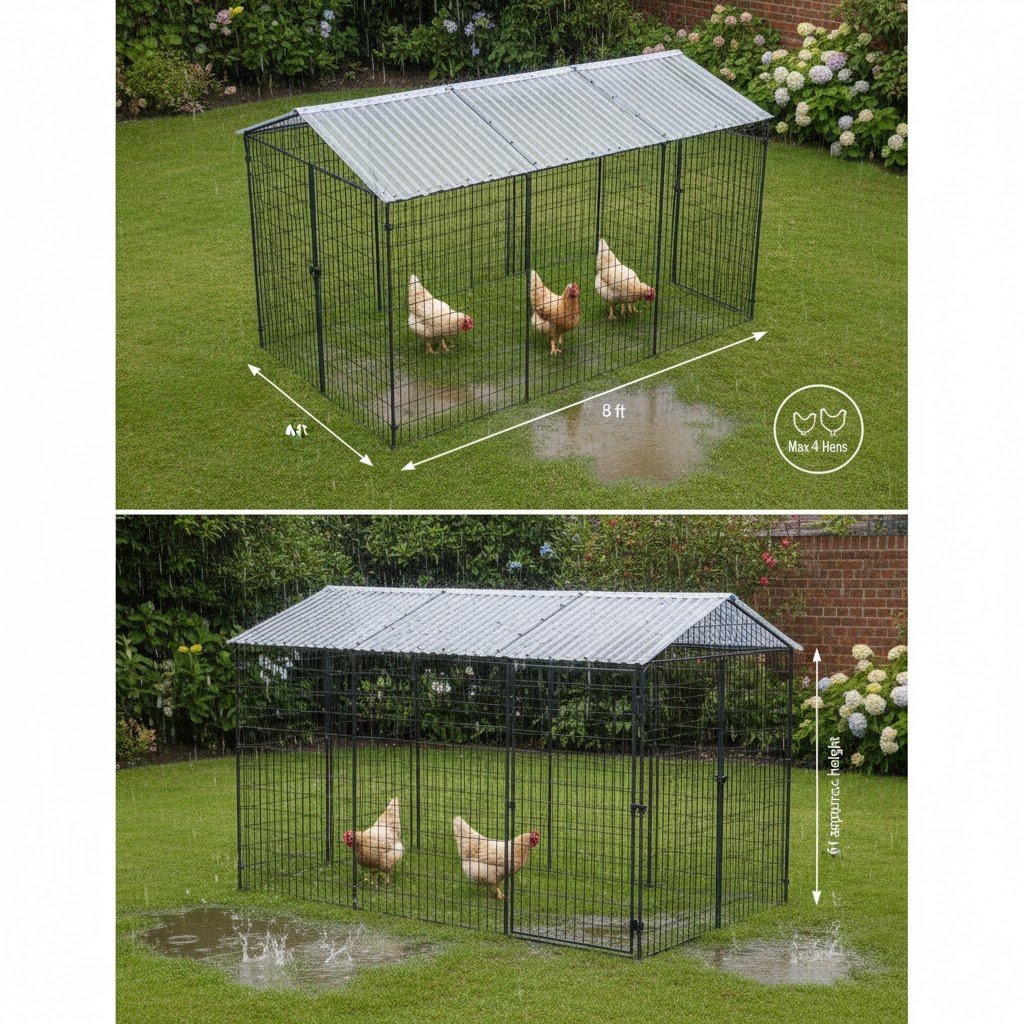
Planning for the Future
A common mistake for new keepers is not planning for ‘chicken maths’—the mysterious way a flock of three hens somehow turns into six! My advice is to always buy a run that is a slightly bigger than you think you need. A modular run, like the Omlet, is a great choice as you can easily add extensions later. For example, if you’re starting with 5 hens (expecting 20-30 eggs a week, as covered later), aim for at least 50-100 sq ft to avoid overcrowding.
Getting the size right is your foundation for a happy flock. Once you know how much space you need, it’s time to explore the different types of runs available on the market.
Walk-In Chicken Run Review: Comparing the Best Kits in the UK 2025
Now for the fun part! Let’s look at some of the best walk-in chicken runs you can buy in the UK. I’ve chosen these based on durability, safety, value for money, and how well they stand up to our weather.
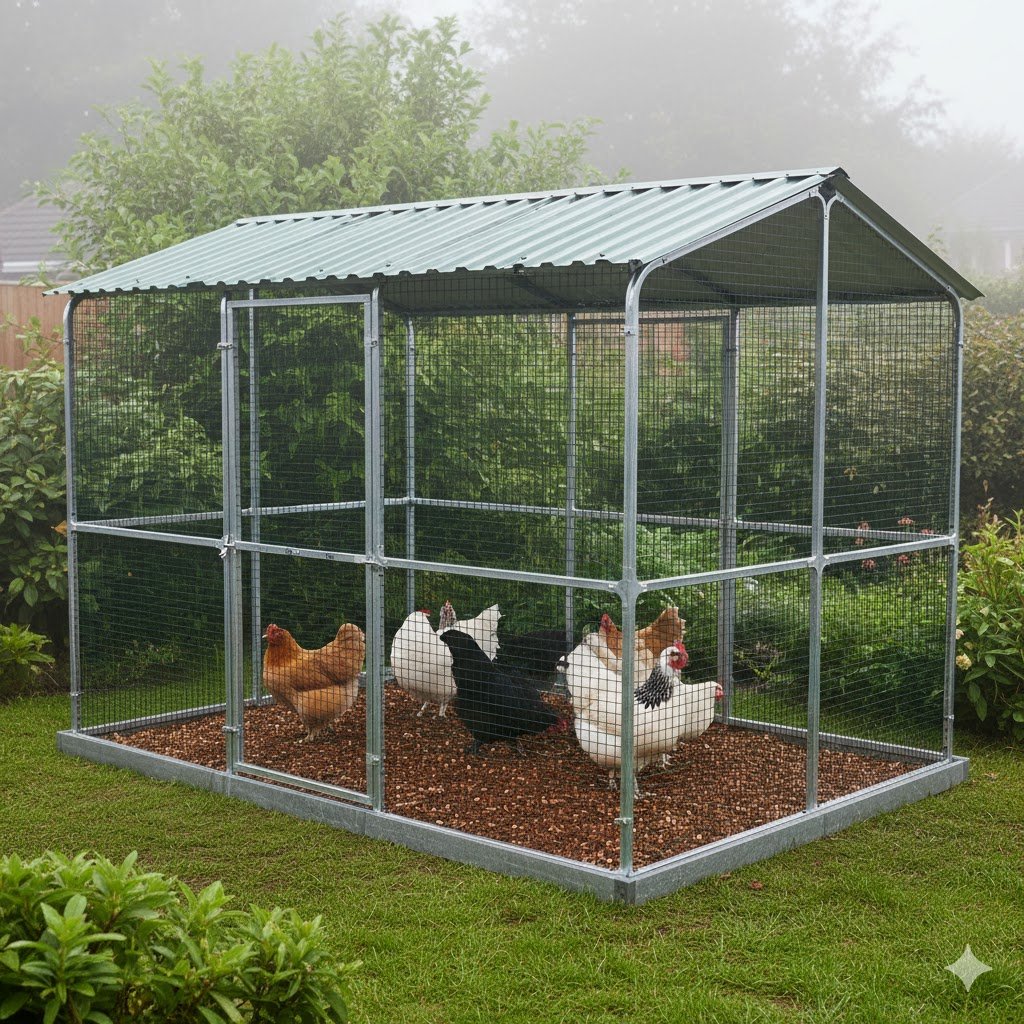
Disclosure: This post may contain affiliate links. I only recommend products I have personally tested, researched, or believe in.
Key Features to Compare When Buying
Before we dive into the reviews, here’s a quick checklist of what to look for:
- Mesh Quality: Look for galvanised steel weld mesh, not chicken wire. The wire should be at least 19-gauge (around 3mm) and the holes no bigger than 50mm x 25mm to stop all predators.
- Frame Material: Galvanised steel is the top choice for durability. Treated wood is attractive but needs more care.
- Roofing System: Does it come with a waterproof cover? Is the whole roof meshed? A roof is vital for biosecurity and weather protection.
- Door and Lock: The door should be tall enough for you to walk through comfortably. The lock should be a sturdy bolt that a fox can’t flip open.
- Anti-Dig Skirt: A mesh skirt around the base is the best defence against digging predators.
- Portability: For modular outside chicken run setups, check if it’s easy to relocate.
Our Top Picks for 2025:
1. Omlet Walk-in Chicken Runs (Best for Predator-Proofing)
- What it is: A modular, heavy-duty metal run with a dark green anti-tunnelling skirt. Omlet is a top name in the UK for a reason.
- Pros: It’s incredibly fox-proof. The small mesh size and deep skirt are practically impenetrable. The modular design is fantastic for extending later. The unique stable-style door lets you pass in treats without a hen escaping.
- Cons: It’s a premium product with a premium price, starting around £300. The assembly uses lots of plastic clips which can be tough on the hands.
- Ideal for: The security-conscious keeper in a high-risk fox area who wants a long-term, flexible solution. It’s a true walk in chicken run fox proof champion. For a deeper look at Omlet’s ecosystem, read our full Omlet Eglu Cube review. If you’re considering Omlet, see our Omlet vs. Framebow comparison for more modular options.
2. Alphapet Heavy Duty Metal Chicken Run (Best Value for Durability)
- What it is: A galvanised steel run with a strong frame and a waterproof, UV-resistant roof cover included.
- Pros: Excellent value for money, often under £200 for a decent size. The galvanised steel frame won’t rust easily. The included roof cover is a huge bonus for keeping a large area dry.
- Cons: The included mesh might have larger holes than premium brands. Consider adding a layer of finer weld mesh around the bottom foot for maximum security against stoats.
- Ideal for: Anyone wanting a robust, weatherproof run without the premium price tag. It’s a solid, heavy duty metal chicken run.
3. PawHut Pre Made Chicken Run (Best Affordable Option)
- What it is: A budget-friendly metal run that often comes with a roof cover.
- Pros: Very affordable, making it accessible for beginners. It’s a pre made chicken run kit that is relatively simple to build.
- Cons: The wire mesh is thinner and the frame less substantial than pricier models. You absolutely must add a DIY anti-digging skirt around the base.
- Ideal for: Beginners on a tight budget who are willing to make some DIY security upgrades. It pairs well with the best affordable chicken coop for a complete, budget-friendly chicken coop and run combo under £300.
4. Home & Roost Wooden Chicken Runs (Best for a Natural Look)
- What it is: Attractive runs made from FSC-certified, pressure-treated timber.
- Pros: These wooden chicken runs look beautiful and blend seamlessly into a traditional garden. The wood feels sturdy and well-made.
- Cons: Wood requires yearly maintenance with a pet-safe preservative to prevent rot. Red mites love hiding in the crevices, so you need to be extra vigilant with cleaning.
- Ideal for: Those who prioritise garden aesthetics and are happy to commit to regular maintenance.
5. Walk-in Chicken Runs for Sale at Flyte So Fancy (Best for Customisation)
- What it is: A UK-based family business offering high-quality modular runs.
- Pros: You can practically design your own run to fit any garden shape. They offer different heights, widths, and door options. The quality is exceptional.
- Cons: Being a bespoke, high-quality option, they are more expensive.
- Ideal for: Keepers with awkward garden spaces or very specific requirements who want a top-quality, British-made product.
At a Glance: Cost & Value Comparison
(Based on average 2025 pricing; check current retailers for exact figures.)
| Product | Starting Price (approx.) | Sq Ft Covered (typical) | Value Rating (Out of 5) | Notes |
|---|---|---|---|---|
| Omlet Walk-in Run | £300 | 50-100 | 4.8 | Premium security and modularity |
| Alphapet Run | £200 | 40-80 | 4.5 | Durable metal for the price |
| PawHut Run | £150 | 30-60 | 4.0 | Affordable entry-level option |
Seeing the top products is helpful, but the fundamental choice for many keepers comes down to one thing: wood or metal. Let’s break down that decision to see which material truly suits the demanding UK climate.
Wooden Chicken Runs vs. Metal Chicken Run with Roof: Pros and Cons for UK Backyards
This is the big debate! Here’s a more detailed look to help you decide.
The Hidden Dangers of Wood: Red Mite and Rot
Wood might look lovely, but it has two major enemies in the UK: damp and pests. Red mites are tiny blood-sucking parasites that hide in cracks in the wood during the day and feed on your chickens at night. They are incredibly difficult to get rid of. Damp weather also leads to wood rot, which can weaken the structure and make it unsafe. (This is general advice—consult a vet for specific issues regarding pests and flock health.)
The Practicality of Metal: Cleaning and Biosecurity
A metal chicken run with roof is far more practical for the modern keeper. It’s easy to hose down and disinfect, which is vital for preventing the spread of diseases. In an era of Avian Influenza concerns, a cleanable, covered run is a key part of good biosecurity.
| Feature | Wooden Runs | Metal Runs |
|---|---|---|
| Durability | Prone to rot; needs yearly maintenance. | Excellent; galvanised steel lasts for decades. |
| Predator Security | Good, but can be chewed through. | Excellent; cannot be chewed or broken. |
| Maintenance | High; requires annual treating. | Low; just needs occasional cleaning. |
| Pest Control | Poor; harbours red mites. | Excellent; no hiding places for pests. |
| Aesthetics | Natural, traditional look. | More modern, industrial look. |
My Recommendation: For most UK keepers, a metal chicken run with roof is the superior choice. The low maintenance and high security are perfect for our climate and give you priceless peace of mind. In 2025, with rising eco-trends, look for galvanized steel runs like Alphapet’s for a sustainable, low-waste option.
Whether you choose wood or metal, you can make any run a fantastic space. Now, let’s get creative and explore how to make the most of your garden, no matter its size.
Best Chicken Run Ideas and Walk In Chicken Run Ideas for Small UK Gardens
Even a tiny garden can house happy hens with a bit of creativity. Beyond just buying a kit, thinking about how your run works in your space is key. Here are some actionable walk in chicken run ideas to inspire you.
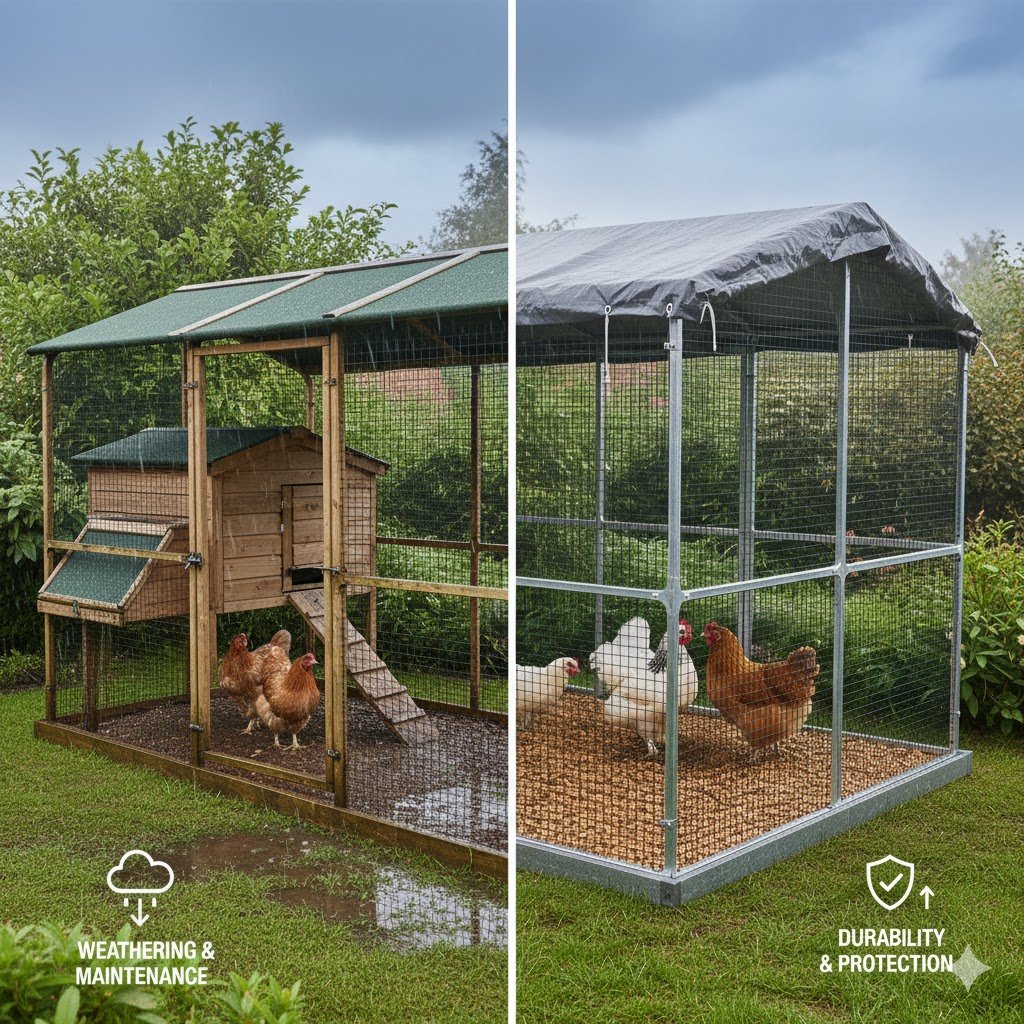
Smart Design Principles for Any Run
- Go Vertical: Don’t just think about floor space. Add wide, sturdy branches for perches at different heights. A chicken swing provides movement and fun. You can even build a small platform to give them a lookout point.
- Create Zones: Use logs or small A-frame shelters to break up the space. This creates a dedicated dust-bathing area, a sheltered spot, and a foraging corner, which reduces boredom and squabbles.
- Elevated for Drainage: To permanently solve the mud problem, build a shallow frame from timber sleepers at the base of your run. Fill this with a deep layer of a free-draining material like woodchip.
DIY Walk In Chicken Run Ideas Using Pre Made Panels and Materials
- The Lean-To Run: Save space and materials by building your run against a sturdy shed or garden wall. This provides one solid side for free, offering extra shelter from the wind.
Walk In Chicken Run Ideas for Fox-Proof Setups
- DIY Walk In Chicken Run Ideas: Use pre made chicken run panels from recycled wood for a custom wooden chicken run—add chicken run roofing from a heavy-duty tarpaulin for a complete setup under £100.
- Heavy Duty Walk In Chicken Run Ideas: Integrate a metal chicken run with roof into raised garden beds. This elevates the run, providing excellent drainage in wet UK soils and making it harder for predators to dig underneath.
- Creative Best Chicken Run Ideas: Position your walk-in chicken runs adjacent to a herb garden with strong-smelling plants like mint and lavender. This can help deter pests and creates an attractive, eco-friendly enclosure for your flock.
Integrating Your Run with Your Coop and Garden
- Connecting to the Best Affordable Chicken Coop: A common mistake is buying an all-in-one package with a tiny run. A smarter strategy is to buy the best affordable chicken coop separately and connect it to a large walk-in run. This gives you a budget-friendly house and a spacious, safe enclosure.
- Making it a Garden Feature: Make your run an attractive part of your garden. Plant chicken-safe, aromatic herbs like lavender and rosemary around the perimeter to deter pests. Lay a simple slab path to the door to avoid treading mud everywhere.
Great ideas can make a run beautiful and functional, but its primary job is protection. Let’s face the reality of UK predators and how to build an impenetrable fortress for your flock.
What is the Number One Killer of Chickens? And How a Walk In Chicken Run Fox Proof Design Helps
Let’s be direct: the number one killer of backyard chickens in the UK is the fox. According to organisations like the British Hen Welfare Trust (BHWT), fox attacks are heartbreakingly common, especially in towns and cities. Last winter in my rainy Manchester garden, a fox tried digging under my old run—thankfully, the anti-dig skirt held, but it scared me straight into upgrading my setup! In my experience, a walk in chicken run fox proof like Omlet’s anti-dig skirt buried 50cm deep stopped a repeat attack last year.
Beyond the Fox: Other UK Predators
While foxes are the main threat, you should also be aware of:
- Badgers: Incredibly strong diggers. An anti-dig skirt is essential protection.
- Stoats and Weasels: Can slip through very small gaps. Your mesh holes should be no wider than 25mm.
- Birds of Prey: Buzzards and other large raptors can sometimes target smaller bantam chickens. A solid or mesh roof is the only way to stop this.
A Step-by-Step Guide to Securing Your Run
A walk in chicken run fox proof design isn’t just one feature—it’s a system. Here is an actionable checklist:
- Choose Strong Mesh: Before buying, confirm the mesh is galvanised steel weld mesh, not flimsy chicken wire.
- Install the Skirt: Lay the anti-tunnelling skirt flat on the ground, pointing outwards, and peg it down firmly. Cover it with turf or paving slabs to secure it.
- Secure the Door: Foxes can learn to lift simple bolts. Use a lock that requires turning, or add a carabiner clip as a secondary lock.
- Cover the Top: Never leave a run open-topped. A full roof is non-negotiable.
- Perform Regular Checks: Walk around the perimeter of your run once a week, looking for any signs of digging or attempts to breach the wire.
Pair your run with one of the best fox-proof chicken coops in the UK for full protection.
A secure frame is vital, but what’s underfoot is just as important for your hens’ health and happiness. It’s time to talk about flooring and how to win the war against mud.
What Flooring is Best for a Chicken Run? And What is the Best Ground Cover for a Chicken Run?
The floor of your run will get a lot of use, so choosing the right cover is key to keeping it clean and preventing a muddy mess.
The Deep Litter Method: A No-Clean Solution
A fantastic, low-effort option for UK keepers is the ‘deep litter method’. You start with a deep (6-8 inch) layer of a carbon-rich material like hardwood woodchip. As the chickens add their nitrogen-rich droppings, you simply rake it over and add a fresh thin layer of woodchip on top every few weeks. The material composts in place, creating a healthy, warm, and odour-free floor that your chickens will love scratching in.
Substrates Compared
| Substrate | Cost | Drainage | Maintenance | Enrichment Value |
|---|---|---|---|---|
| Sand | Medium | Excellent | Easy to rake and clean. | Excellent for dust baths. |
| Hardwood Woodchip | Medium | Good | Low; ideal for deep litter. | Excellent for foraging. |
| Grass | Free | Poor | Turns to mud in days. | High, but short-lived. |
| Gravel | Low | Good | Medium; use pea gravel for drainage but top with woodchip. | Low (used as a base) |
| Straw/Hay | Low | Very Poor | Gets soggy and mouldy. | Poor; can cause health issues. |
For most UK runs, a deep base of hardwood woodchip is the best all-round choice. It handles the rain, provides enrichment, and keeps the run clean and healthy, aligning with advice from the BHWT on creating healthy environments. Avoid fine play sand, as it can cause crop issues—opt for coarse builder’s sand instead (per BHWT 2025). For enrichment, learn how to set up a dust bath for chickens in your run.
With a safe structure and a clean floor, you have the perfect stage. Now let’s consider the actors—which chicken breeds are best suited to thrive in your new run?
What is the Quietest and Calmest Chicken? Pairing Breeds with Your Walk-In Chicken Run
If you live in a suburban area, choosing a quiet breed is a considerate choice for your neighbours.
- Best for Calm Temperaments: Buff Orpingtons, Sussex, and Brahmas are famously placid and friendly (per RSPCA guidelines). They thrive in a spacious walk-in chicken run where they feel safe and unstressed.
- Best for Small Runs: If your space is limited, consider bantams. Silkies and Pekin Bantams are small, quiet, and don’t need as much room as larger breeds.
- Most Active Foragers: Breeds like Leghorns and Welsummers love to search for food. They will make the most of a large, enriched run where they have plenty to explore.
Even a calm breed will get noisy if it’s bored, so a good run setup is just as important as your choice of hen. Discover more in our guide to the quietest chicken breeds for backyards.
Choosing the right breed impacts your daily life, but it also impacts your breakfast! Let’s look at the practical output of your flock to help finalise your size and breed decisions.
How Many Eggs Will 5 Chickens Lay a Week? Planning Flock Size for Your Run
For a flock of 5 healthy, young hybrid hens (like a Sussex or a Warren), you can expect about 20-30 eggs per week. However, this isn’t guaranteed year-round. To maximize this in your run, ensure at least 10 sq ft per hen to reduce stress and boost laying (a key factor noted by both the RSPCA and the BHWT).
Factors That Affect Egg Laying
- Daylight Hours: Production naturally drops in winter when the days are shorter.
- The Moult: Once a year, hens lose their old feathers and grow new ones. They stop laying during this time to conserve energy.
- Age: A hen’s peak laying years are her first two. Production will slowly decline after that.
- Broodiness: Some breeds, especially traditional ones, will decide they want to sit on eggs and become ‘broody’, stopping laying for several weeks.
Knowing this helps you plan your flock size realistically. A flock of 3-4 hens in a 4×8 ft run will keep a family well-stocked with fresh eggs for most of the year.
Your hens are safe, comfortable, and providing you with eggs. The final piece of the puzzle is making sure they are happy and stimulated within their excellent new home.
How Do You Keep Chickens from Getting Bored? Enrichment Ideas for Walk-In Chicken Runs
A bored chicken is an unhappy chicken, a fact stressed by welfare charities like the British Hen Welfare Trust. A walk-in run gives you the perfect space to add fun activities to keep their minds and bodies active.
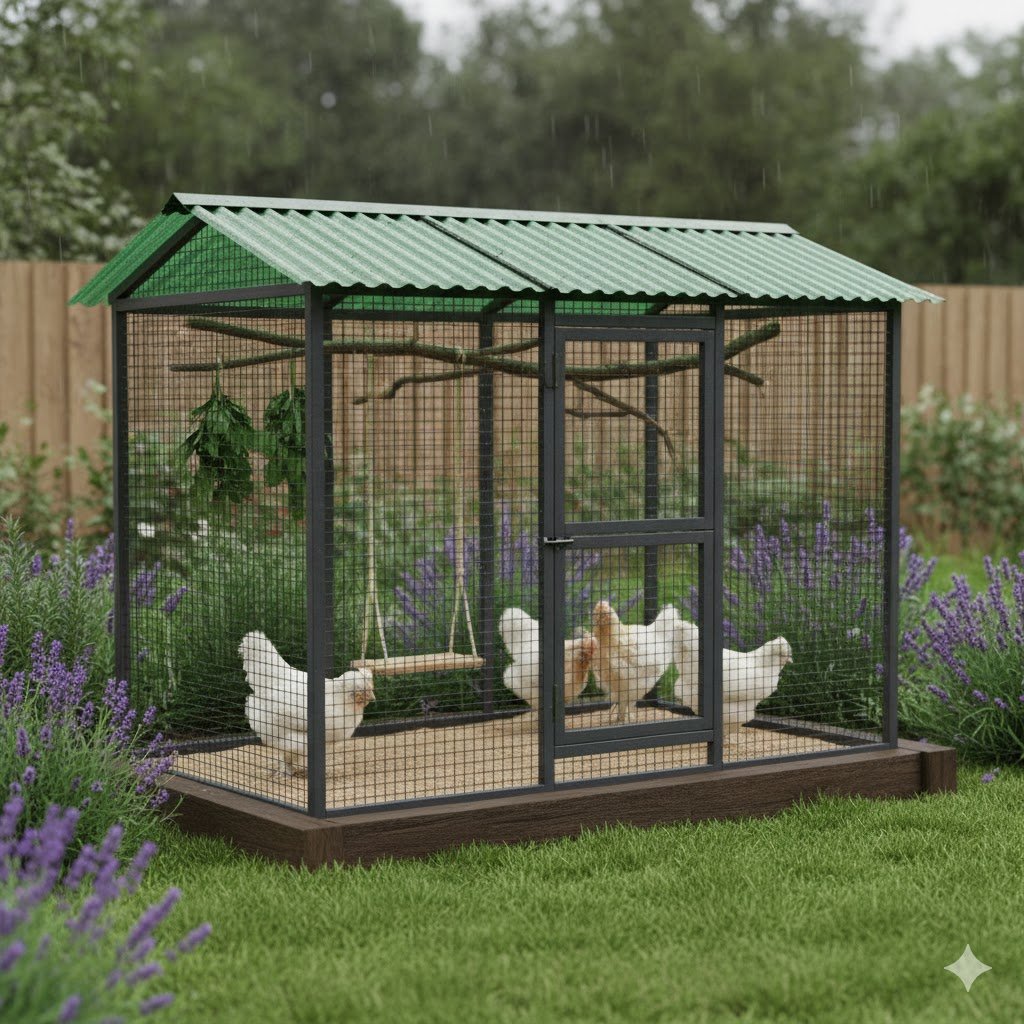
Foraging and Food-Based Enrichment
- Scratch Mix: Instead of putting all their food in a feeder, scatter a handful of mixed corn onto the floor each afternoon to encourage natural scratching behaviour.
- Puzzle Feeders: Hide treats in a cabbage for a ‘vegetable piñata’—hens peck for hours. You can also use commercial puzzle feeders or a clean plastic bottle with holes drilled in it to dispense treats like dried mealworms, providing great mental stimulation (a key BHWT 2025 recommendation for welfare).
- Compost Corner: Designate one corner of the run as a safe compost heap. Add chicken-safe garden waste (grass clippings, weeds, vegetable peelings) and let them scratch through it, searching for tasty bugs.
Structural Enrichment for a More Interesting Run
- Logs and Stumps: A few logs or tree stumps of different heights provide perching spots and are great for scratching.
- Create a ‘Jungle Gym’: Securely stack logs, branches, and even an old wooden ladder to create different levels for perching and exploring. This adds complexity to their environment and makes use of vertical space.
- Shelter and Shade: Even with a roof cover, adding a small A-frame shelter or planting a small, robust bush in a protected corner gives them a place to hide from the wind or sun.
- Mirrors and Swings: A shatterproof mirror sparks curiosity in your hen foraging space. A simple swing made from a sturdy branch can also provide hours of entertainment.
Boost this with our tips to encourage natural foraging in chickens.
We’ve covered what to buy, how to secure it, and how to make it a wonderful home. But keeping chickens is an ongoing job, so let’s look at how to manage your run throughout the year.
Year-Round Run Management: A UK Keeper’s Calendar
A chicken run needs to perform in the depths of a wet winter and during a summer heatwave. Here’s how to prepare for the seasons.
Tackling Winter: Mud, Rain, and Boredom
The biggest challenge in a UK winter is mud. A deep litter of woodchip is your best defence. Ensure your chicken run roofing covers as much of the run as possible to keep the ground dry. Add extra enrichment, like hanging vegetables, to combat boredom when the flock is cooped up during bad weather. Check their water regularly to ensure it hasn’t frozen. For full seasonal prep, see our winterizing your chicken coop guide, adaptable to runs.
Summer Sanity: Shade, Water, and Pest Control
In summer, the priorities shift to cooling and hydration. Your roof cover will provide essential shade, but you can also add a small dust bath in a shaded corner. Ensure they have multiple water sources, and add some ice cubes on very hot days. Summer also brings more flies and mites, so keep the run extra clean to manage pests.
Seasonal care is crucial for your flock’s health, but so is your relationship with the wider world. Let’s cover the important topics of disease prevention and being a considerate neighbour.
Biosecurity and Being a Good Neighbour
Keeping chickens comes with responsibilities, both to your flock and your community.
Practical Biosecurity for Your Backyard Run
With the ongoing risk of Avian Influenza, good biosecurity is essential. This means preventing disease from entering your flock.
- Footwear: Keep a dedicated pair of wellies or boots just for the chicken run. Don’t wear them anywhere else.
- Disinfectant Mat: Place a shallow tray with a government-approved disinfectant at the entrance to your run to dip your boots in before entering.
- Wild Bird Prevention: A fully covered run is your best tool. It stops wild birds (and their droppings) from getting in and contaminating the area. With UK-wide prevention zones in place through at least December 2025 (per DEFRA), a fully covered run prevents wild bird contact and mandatory housing orders.
Keeping the Peace: Noise, Smells, and Escaped Hens
- Noise: Don’t keep a cockerel unless you live in a rural area. Hens are generally quiet, but the ‘egg song’ after laying can be loud. Most neighbours don’t mind this brief daily announcement!
- Smells: A well-managed run doesn’t smell. Use the deep litter method and clean up any spilled food promptly. A smelly run is usually a sign that it’s too wet or needs cleaning.
- Escaped Hens: A secure run prevents escapes, which can upset neighbours, especially if they are keen gardeners.
You are now equipped with all the knowledge to choose, build, and manage the perfect run. We have covered every angle to ensure you make the best decision for you and your future flock.
Frequently Asked Questions (FAQ)
Here are quick answers to some of the most common questions about walk-in chicken runs in the UK.
Q: What size walk in chicken run do I need?
A: For a happy flock, aim for at least 2 square metres (approx. 21 sq ft) per hen, as recommended by the RSPCA. The absolute minimum is 1 square metre (approx. 10 sq ft) per bird. More space is always better to reduce stress and boredom.
Q: How many chickens can fit in a 4×6 run?
A: A 4×6 ft run (24 sq ft) can house a maximum of 2-3 hens according to UK welfare guidelines. It’s best suited for a very small flock that also gets plenty of time to free-range.
Q: How many chickens can fit in a 10×10 run?
A: A 10×10 ft run (100 sq ft) is a great size for a flock of 8-10 hens, providing ample space for them to live comfortably.
Q: What is the best flooring for a chicken run in the UK?
A: The best options for the damp UK climate are hardwood woodchip or coarse builder’s sand. Both provide excellent drainage and prevent the run from turning into a mud pit. The deep litter method using woodchip is a popular low-maintenance choice.
Q: Are wooden or metal chicken runs better?
A: For the UK, metal chicken runs are generally superior. They are more durable against rain, easier to clean (which helps prevent red mites), and offer better protection from predators like foxes who can chew through wood.
Q: How do I make my chicken run fox-proof?
A: A truly fox-proof run needs several key features: strong steel weld mesh (not chicken wire), a secure roof, a sturdy lock on the door, and an anti-digging mesh skirt that is buried at least 30-50cm deep around the entire perimeter.
Conclusion: Your Perfect UK Chicken Run Awaits
As this walk-in chicken run review shows, choosing the right enclosure is the key to happy hens and a happy keeper. Whether you go for a tough metal chicken run with roof to defeat the foxes or a beautiful wooden chicken run that complements your garden, the most important thing is to provide enough space and safety.
Before you make a final decision, measure your garden, decide on your flock size, and be honest about your budget. You can find excellent walk-in chicken runs for sale from brands like Omlet and Alphapet that offer brilliant protection.
Finally, a quick reminder: as of 2025, it is a legal requirement in the UK to [register your flock with the Animal and Plant Health Agency (APHA), even if you only have one bird. It’s free and easy to do online.
Happy chicken keeping!

Oladepo Babatunde is the founder of ChickenStarter.com. He is a backyard chicken keeper and educator who specializes in helping beginners raise healthy flocks, particularly in warm climates. His expertise comes from years of hands-on experience building coops, treating common chicken ailments, and solving flock management issues. His own happy hens are a testament to his methods, laying 25-30 eggs weekly.
